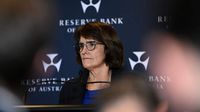The National Australia Bank (NAB) has positioned itself as the first of the Big Four banks to predict a significant interest rate cut from the Reserve Bank of Australia (RBA) in May. Following a tumultuous week in global markets, exacerbated by U.S. President Donald Trump’s recent tariff decisions, NAB forecasts a drop in the official cash rate from the current 4.10% to 3.60% during the RBA’s upcoming meeting on May 19-20, 2025.
According to NAB’s chief economist, Sally Auld, the economic landscape has shifted dramatically since the RBA’s last meeting in early April. “Much has changed since the RBA Board met in early April,” Auld stated. She noted that risks to both global and domestic growth have shifted to the downside, rendering the RBA’s current restrictive policy inappropriate. The economic uncertainty stemming from the international trade environment has led to fears of a recession in Australia.
“Our call for a 50bps easing in May reflects the fact that with the real cash rate of 1.3% and policy currently restrictive, the RBA needs to play catch up,” Auld explained. If the bank’s forecast materializes, homeowners with a $600,000 mortgage could see their monthly repayments decrease by approximately $181, bringing their average monthly payment down to about $3,707.
While NAB is predicting a bold move, it is not alone in anticipating cuts. Commonwealth Bank of Australia (CBA), Westpac, and Australia and New Zealand Banking Group (ANZ) are all forecasting a 25 basis point cut in May. However, NAB stands out with its prediction of five total cuts—one in May, followed by additional reductions in July, August, November, and February 2026—bringing the cash rate down to just 2.60% by early next year.
“A weaker global backdrop and the impacts of weaker consumer and business confidence have now shifted the distribution of risks away from a tighter labor market and towards the risk of a rise in the unemployment rate,” Auld added. This sentiment echoes concerns that the indirect impacts of global tariffs could further strain the Australian economy.
The turmoil in the Australian Stock Exchange (ASX) and other financial markets has intensified discussions around the RBA’s monetary policy. Canstar’s data insights director, Sally Tindall, noted that while a double rate cut could be on the table, it remains unlikely. “It’s difficult to see the data-driven RBA firing off a double cut when it next meets in May. The highly methodical central bank usually likes to take time to see how volatile events play out in the Australian economy,” Tindall remarked.
Despite the uncertainty, the potential for significant savings on mortgages has caught the attention of many Australians. If NAB’s predictions hold true, a $750,000 mortgage could see repayments drop by $226, while a $1 million mortgage might experience a reduction of $302 per month.
The RBA has faced criticism from homeowners and economists alike for maintaining the cash rate at 4.10% despite the growing pressures on the economy. As Auld pointed out, the central bank’s restrictive stance is no longer suitable given the current economic climate. “Managing the risks associated with each of these channels argues for a shift to a more preemptive policy response by the RBA,” she stated.
As the RBA prepares for its next meeting, all eyes will be on how it responds to the evolving economic landscape. The bank’s decisions will not only impact mortgage holders but also influence broader economic activity in Australia. The potential for rate cuts could provide much-needed relief for homeowners struggling with inflationary pressures.
In addition to NAB’s forecasts, other major banks have shared their expectations. CBA and Westpac both predict three cuts in May, August, and November, aiming to bring the cash rate down to 3.35% by the end of the year. ANZ aligns with this forecast, expecting similar cuts to achieve the same target.
As the RBA navigates these turbulent waters, its upcoming decisions will be closely monitored by economists, policymakers, and the public alike. The stakes are high, as the central bank’s actions could shape the economic outlook for Australia in the coming months.
In summary, the NAB's forecast for a significant interest rate cut in May signals a shift in monetary policy in response to mounting economic pressures. With predictions of further cuts throughout the year, the RBA may be poised to provide relief to mortgage holders and stimulate economic activity amid global uncertainties.








